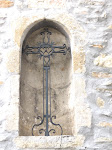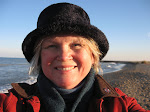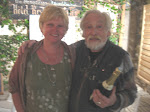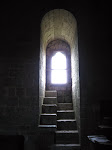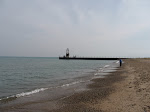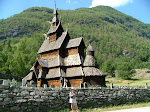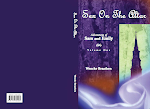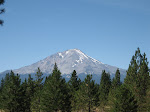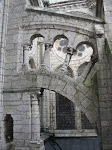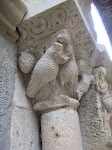"RITUALS IN SACRED STONE", to be published by the end of March.
It's been a some time since I wrote an entry. I've been busy with the publishing process of the book. (And Christmas and my birthday.)
It is now ready for the first printing, and I'm feeling like a squirrel running up and down trees. I'm of course excited about this development, but I'm also scared to death. The research and the writing of this work has all been a very private process. Now it's all becoming public. I'm birthing a baby. I'm on the outward journey after an inward one, where I've retreated to my little room and dived into my story, walking with my characters and feeling their emotions through this dramatic story. It's been a heartwrenching experience. Mary Magdalene's life was filled with danger and heavy decisions. She was burdened with her heritage and her knowlegde. They led her to make crucial choices at difficult crossing points leading her to secretly carry a lot of information she would rather not be privelieged to have.
I've always felt that the story of the head of John the Baptist was missing some crucial elements. Young Salome wouldn't have the desire for a man's execution. There is more to the story. In one version, she consults her mother, before she presents her wish. I looked up her mother, and found that her name was Herodias, the widow of Herod Philip, who upon her husbands death was forced to marry his brother, Herod Antipas. Now the plot thickens. I also found that John the Baptist had protested against the behavior of Antipas, who had divorced his previous wife to marry Herodias, and was trying to get into the council at the Temple of Jerusalem. According to the Jews, divorce was not allowed, and only Rabbis could be on the council. What was Antipas trying to do, being a Roman with no Jewish connections? Now we have a political hornets nest which the good Baptizer put his religious nose right into.
As I researched Herodias, I found that she was educated at Ephesus, famous for it's oracle, and that she had a following of admirers. Now we have a much more interesting set up for the story.
The more I looked into the mystery schools in function at their time, I found that they all respected each other and students traveled between the different temples to learn the different traditions. The druids had their universities, the Egyptian temples had their temple schools, and the exchange of information was welcomed.
There was a different focus for the religious centers. They weren't focused on worshiping the Gods. They were working with the Gods, in the focus of the temple in questions. They were all presenting different paths to relate to the unseen forces functioning between us, whether you used them for healing, to communicate with God or to take the journey of Osiris. All the different ways were valid and seen as different paths to God.
And today we are fighting over which way to worship God, to the point of disagreeing on which hymn to sing.
It is very likely that Mary Magdalene was a highly educated priestess of rank in several temples. There were things happening around Christ which shows that they worked across many traditions and used elements from the Egyptian Journey of Osiris, the healing thechnique from the Therapautae group, the wisdom of the Nazareeans and the Essenes, and older wisdom of the Torah.
I found that the temple of Serabit on top of Sinai knew how to make monoatomic gold and how to work with it. It could be ingested to produce enlightenment from within, or it could be used as an advanced architectural technology to build pyramids.
I was now introduced a world very different than our own, and very very different than the passive church going of our time which passes as relationships to God. To these people, God was a concept that lived inside you. It was a force you learned to work with. The world behind the veils was somewhere you could learn to visit and come back from.
Did Herodias know how to create an oracle? Was the head of John the Baptist presented at the birthday party of Antipas not the product of a brutal and gory exectution, but a product of a planned operation creating an oracular head which could be woken up by an educated priestess from Ephesus? And why did Herodias want it? Or did she want it back? What happened to it afterwards? And why do we have two places, one in Spain and one in Turkey, that claim to have the head of John the Baptist on display?
On my pilgrimage through France finding the footsteps of Mary Magdalene in the Languedoc and Provence, I visited a church in a mountain town between Aix-en-Provence and Marseille. This cathedral was dedicated to the Holy Balm, and I wondered what significance this herbal product could have. In their crypt they had a head on display. They claimed it was the skull of Mary Magdalene.
I was full of questions as I descended the stairs. Did someone desecrate her grave? Did they dig her up at some point and give a bone to various different churches that qualified? I actually didn't run across any other relic of her body in my travels. So why was this head saved, prepared and put on display? It was a skull with some skin still on it and some hair on one side. Was it prepared as an oracle by an expert priestess from Ephesus?
The book is coming out by the end of March. See what I found out over eight years of research and pilgrimage, both in interesting landscapes and in my own inner worlds. "Rituals in Sacred Stone" became a controversial interpretation of one of the most mysterious and compelling women in history; wife, priestess and queen, Mary Magdalene.
Tuesday, February 19, 2013
Subscribe to:
Comments (Atom)



